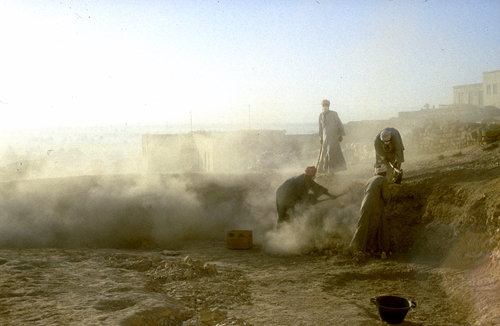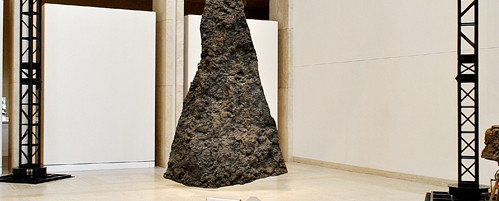From the architectural marvels like the Great Sphinx and the pyramids to the ancient tomb of the child-king Tutankhamen, ancient Egypt has long captured the world’s imagination.
Tomb raider

From the architectural marvels like the Great Sphinx and the pyramids to the ancient tomb of the child-king Tutankhamen, ancient Egypt has long captured the world’s imagination.
But as Dr. Nigel Strudwick, visiting professor of Egyptology at the University of Memphis, is quick to point out, it’s not the high-profile relics that are providing insight into the ancient kingdom but the everyday objects found in the less-reported tombs.
Strudwick has spent the last 20 years excavating and poring over the details of one such site, the tomb of Senneferi at Luxor, in Egypt, as part of the Cambridge Theban Tombs Project. On Saturday, he will lecture at Portland State on his excavation’s finds, which involves a complex story that begins as early as 1450 B.C.
“We’ve found a number of different things. We’ve put together a reasonably reliable history of the tomb from about 1450 B.C. through today,” Strudwick said. “We know that other than [Senneferi], some of his immediate family members were buried there.”
Strudwick also explained that the tomb has seen multiple forms of reuse over the centuries, including as a place where Amenhotep, Senneferi’s son-in-law, had himself commemorated. A statue of Amenhotep was among the more significant recoveries made early in Strudwick’s excavation process. Amenhotep’s own tomb was later discovered by a Belgian mission in 2009.
“We also know how the tomb was used and re-used again from about 1000 B.C. or so down through the next 1300 years,” Strudwick said. “That’s also quite important because a lot of this has been ignored in the past or thrown away—it isn’t very beautiful. It’s not about high-value antiquities, but there’s a lot of informational value.”
The buried mysteries of the ancient Egyptian kingdom have long been a source of archeological interest. But only relatively recently have Egyptologists focused on the information rather than the artifacts found buried in the tombs.
“It was for far too long about finding nice objects instead of finding information, which was almost incidental, whereas now we try to look for the information, not the antiquities,” Strudwick said.
Senneferi’s tomb was not a new find freshly dug by Strudwick’s team. Instead, the so-called TT99 was discovered as early as 1895 among several other nobles’ tombs at Luxor. Egyptologists visited the site over the years but never documented it, according to Strudwick.
“I selected it on the basis that nobody had done anything to it. I also thought, ironically, back in 1992, that it wouldn’t take that long to do it,” he explained. “And 20 years later, here we are, trying to finish it. We finished the fieldwork 10 years ago; it’s just that writing it up has taken time.”
Much of Strudwick’s professional work has been dedicated specifically to working with known monuments rather than seeking new finds.
“When something’s threatened, there’s a strong moral case for making sure that you record and preserve what we’ve known about for years,” he said. “That’s a personal opinion of mine, but I think it’s a good way to proceed.”
And preservation has been a large part of the process for the excavation team. Strudwick illustrated the effort put into the conservation of wall paintings, some of which had suffered extensive damage and sported areas of instability. Teams of conservators have worked on cleaning the walls and treating them to add stability to the weakened spots of artwork.
“A very important thing that I believe in stressing is that it’s important we don’t just go in and take information from Egypt; we also want to put something back into the monument,” he said. “So the wall paintings are not only cleaned; they’re more sturdy and in better preservation than they were 20 years ago.”
Strudwick’s presentation at PSU will include a slideshow and detail the history of the excavation of Senneferi’s tomb.
“My aim is to present an overall rounded picture of what happened in the tomb,” he said. “We can follow the history of this one particular monument for a very long time. We don’t just have details from the five years of when it was being built and the owner was buried in it. We know other people have used it over the years.”
When asked what he believes draws so many readers and history buffs to the idea of ancient Egypt, Strudwick pointed to his own fascination with Egyptology early in life.
He said that many Egyptologists become interested very young and that the same is true for others. And then there is also a lure in the intricate burial practices of the ancient Egyptians.
“A lot of people, particularly starting out as children, are very attracted to Egypt because of the amount of things they’ve left in Egypt. And a lot of people are attracted by the lengths to which Egyptians went to preserve things after they’ve died,” he said. “As a species we’re obsessed with death, so any place where they spend a lot of time and energy making sure people are well-prepared when they’ve died I think just fascinates us.”
Nigel Strudwick on Discoveries in the Tomb of Senneferi, Pharaoh’s Chancellor
Saturday, May 12
5:30 p.m.
Smith Memorial Student Union, room 238
Free and open to the public





